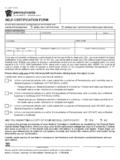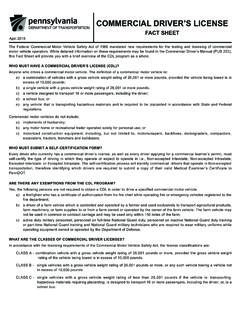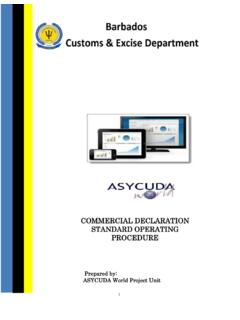Transcription of Security Guidance for Commercial Buildings - hsema
1 Security Guidance for Commercial Buildings District of Columbia Homeland Security and Emergency Management Agency 2720 Martin Luther King, Jr. Avenue, SE. Washington, DC 20032. 202-727-6161. April 2012. GOVERNMENT OF THE DISTRICT OF COLUMBIA. VINCENT C. GRAY, MAYOR. Dear District Homeland Security Partner, The Homeland Security and Emergency Management Agency ( hsema ) is dedicated to sharing information to facilitate prevention, protection, response to, and recovery from all-hazards that might impact the District. As an owner or operator of a Commercial facility in the District, you are a critical partner in ensuring a safe and secure District of Columbia.
2 The information included in this document identifies potential indicators of terrorist activity, common vulnerabilities of Commercial facilities, potential protective measures, and useful references. We encourage you to use the informational guidelines in this document to consider new and improved ways to enhance the Security of your building . Thank you for working to help us realize a safe and secure District of Columbia. For more information, please contact: DC Homeland Security and Emergency Management Agency 2720 Martin Luther King Jr. Avenue, SE.
3 Washington, 20032. 202-727-6161. w w w .hse ma . dc .g o v 1. Table of Contents Introduction .. 1. Real Estate - Office Buildings , Condominiums, self -Storage Facilities .. 3. Public Assembly .. 5. Convention Centers .. 5. Museums, Zoos, Libraries .. 7. Parades, Festivals, Rallies .. 9. Stadiums and 12. Lodging - Hotels, Motels, Conference Centers .. 14. Performance Venues Theaters, Concert Halls, etc.. 16. Retail - Shopping Malls, Retail Centers .. 18. Mail and Package Handling 20. Child Care Centers .. 22. Nursing Homes .. 24. Residential Buildings .
4 26. Active Shooter - How to Respond .. 28. Profile of an Active 28. When an Active Shooter Is In Your Area .. 29. When Law Enforcement Arrives .. 30. Training Your Staff .. 31. Preparing For and Managing the Situation .. 32. Recognizing Potential Workplace Violence .. 33. Managing the Consequences .. 33. Suspicious Packages and Mail .. 35. Bomb Threat: Stand-Off Chart .. 36. Shelter-in-Place .. 38. At Home .. 38. At Work .. 38. At School .. 39. In Your Vehicle .. 40. Shelter-in-Place: Business .. 40. Alert DC System .. 53. Emergency Go-Kit Information.
5 54. DISCLAIMER. The enclosed suggestions should not replace the advice of trained medical staff and police officials. All data compiled here is for informational purposes only and hsema , its employees, and affiliates do not accept responsibility for any injury, loss or damage arising from the use of this information. During a time of crisis, citizens should heed the advice of local officials over the data contained in this reference material. w w w .hse ma . dc .g o v 2. Real Estate Office Buildings , Condominiums, self -Storage Facilities Commercial office Buildings range in size from less than 1,000 to more than 1 million square feet.
6 About 2,000 Buildings in the United States (less than 1% of the total number) have more than 500,000 square feet of floor space, and about 7,000 (nearly 1%) have more than 200,000 square feet. The amount of space in these larger Buildings is significant: nearly 30% of all Commercial office floor space is in Buildings with more than 200,000 square feet. Evidence of unauthorized access to HVAC areas of a building Indicators of potential surveillance by terrorists include: Persons using or carrying video/camera/observation equipment in or near the facility over an extended period Persons discovered with facility maps, photos, or diagrams with critical assets highlighted or notes regarding infrastructure or listing of personnel Persons parking, standing, or loitering in the same area over a multiple-day period with no apparent reasonable explanation Persons questioning facility employees off-site about practices pertaining to the facility and its operations, or an increase in personal e-mail, telephone, faxes.
7 Or postal mail requesting information about the facility or one of its Potential Indicators of Terrorist Activity key assets Terrorists have a wide variety of weapons and tactics available Facility employees inquiring about facility operations, to achieve their objectives. Specific threats of most concern to equipment, assets, or Security measures about which they Commercial office Buildings include: should have no job-related interest Improvised explosive devices An increase in Buildings left unsecured or doors left Arson unlocked, when normally secured and locked at all times Small arms attack Common Vulnerabilities Assassination/kidnapping The following are key common vulnerabilities of Commercial Chemical/biological/radiological agent attack office Buildings .
8 Aircraft attack Lack of adequate perimeter and site Security measures Cyber attack ( , fences, bollards, Security cameras). building designs that lack Security considerations Terrorist activity indicators are observable anomalies or ( , blast-resistant glass). incidents that may precede a terrorist attack. Indicators of an imminent attack requiring immediate action may include the Lack of adequate vehicular control ( , traffic control, following: parking area controls). Persons in crowded areas wearing unusually bulky Lack of Security in loading docks, shipping and receiving clothing that might conceal suicide explosives areas, mailrooms Vehicles illegally parked near facility Buildings or near Open access to Buildings by tenant employees, visitors places where large numbers of people gather Lack of Security at HVAC systems Unattended packages ( , backpack, briefcase, box)
9 That Lack of Security at building utility supply points might contain explosives Limited emergency response and Security forces Suspicious packages and/or letters received by mail that might contain explosives or chemical/biological/ Lack of Security regarding food suppliers radiological agents w w w .hse ma . dc .g o v 3. Protective Measures Develop a process for communicating to building Protective measures include equipment, personnel, and management, employees, and tenants the current procedures designed to protect a facility against threats and to Security situation.
10 Mitigate the effects of an attack. Protective measures for Monitoring, Surveillance, Inspection Commercial office Buildings include: Install video surveillance equipment ( , closed-circuit television [CCTV], lighting). Planning and Preparedness Conduct threat analyses, vulnerability assessments, Install detector and alarm systems. consequence analyses, risk assessments, and Security Continuously monitor all people entering and leaving audits. Develop a comprehensive Security plan and the facility. emergency response plan for the facility. Continuously monitor all vehicles approaching the Conduct regular exercises with facility employees, facility for signs of threatening behavior.







